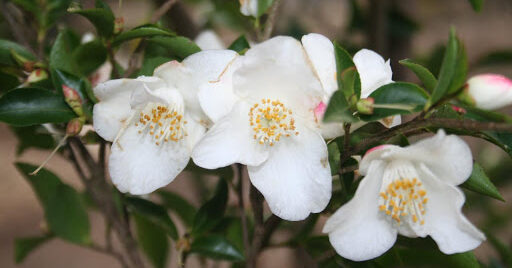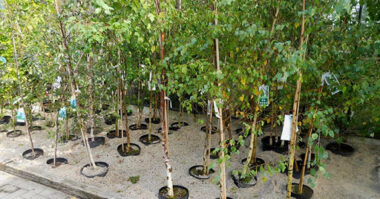The full flowering period of Camellias is the end of winter. These evergreen shrubs of heather earth then offer between six and seven months of uninterrupted flowering, if we take into account the Camellias which started to flower in October and the Camellia japonica, which bloom from February until early April.
Contents
Camellia that grows the fastest
The fastest growing Camellia is the Camellia transnokoensis, its growth can exceed 25 inches/year, reaching 1 foot in height at maturity.
Camellia transnokoensis is a charming country botanical Camellia that deserves to be discovered. With its deep pink topped buds that open into tiny, slightly fragrant white flowers, its pretty airy habit and its young copper and bronze tinted shoots, this little marvel will even seduce the detractors of these shrubs who consider them a little too primed.
The shrub, attractive even outside of its winter bloom, will keep its pretty dark and glossy foliage all year long. To try absolutely, alone in the garden, or in a nice pot on the terrace to be stored in very cold regions.
How to plant Camellia Transokoensis
The Camellia transnokoensis can be placed in a shady or semi-shady place, in the morning or evening sun, absolutely sheltered from cold and drying winds. The best period to operate is from March to April. If you grow it in the sun (not burning), the roots must always remain cool. Plant it in a soil that remains cool, humic, acidic, limestone free and well drained.
Do not plant the shrub too deep, the top of the root ball should be covered with 1 inch. In winter, cover it with a 2 to 3 inches thick mulch composed of leaf compost and crushed bark. Beware of late frosts that can damage flowers and buds. During dry periods, water the shrub to prevent the fall of the flower buds. Pruning is done every year after flowering. Prune lightly the stems which do not allow the shrub to keep its compact aspect.
Remove the faded flowers if you do not want fruits and remove the dead shoots. The adult Camellia supports a severe pruning. Camellia can be prone to rot, leaf spot and viruses. It can be attacked by aphids and scale insects that cause fumagine, as well as by otiorhynchids.
Maintaining the fastest growing Camellia (Transokoensis)
Every 2 or 3 years, add one or two shovels of compost or Bochevo to the ground around the periphery of your camelia. If the foliage of the plant over the years tends to yellow (chlorosis), add iron sulphate to the soil. One or two handfuls from time to time.
Never let the lawn reach the foot of your camellia, you will deprive it of rainwater for more than 6 months of the year. The lawn will consume all this water. On the contrary, clear about one meter around the foot that you will maintain with the mulch.
Remarkable varieties of camellias
Camellia transnokoensis
Rustic and very floriferous, it is covered with 200 to 300 small fragrant white flowers that resemble the flowers of the Japanese quince tree. Its growth is very fast (18 to 25 inches/year). It can reach 1 foot in height. The young spring shoots are red. It is the Camellia that grows the fastest.
Camellia Furo-an
Its less traditional flowers make it look like an ancient rose, revealing a fleshy flower with a yellow heart, with pink petals hemmed with darker pink. Its foliage is broad and dense. This variety blooms until the beginning of April, with a less flowering than the other varieties.
Camellia Tom knudsen
It is the most known variety of red Camellia. It offers peony-shaped flowers. This plant can be trellised against a wall or a fence to occupy less space.
Camellia Margaret Davis
Here is a variety with large white flowers (diameter 4 to 7 inches) hemmed with bright pink. Its growth is rather slow. It is an ideal plant in large pot or in tray, on a balcony or a terrace.
Summary
The Camellia transnokoensis is the fastest growing botanical species of all Camellia, native to the forests of the central mountains of Taiwan, especially on the rocky slopes of Mount Noko, which gave it its species name.
In nature, it forms a beautiful shrub that can exceed 7 m in height, but in our climates it will retain lower proportions. Like all camellias, it belongs to the theaceae family. Its hardiness is around 10°F (USDA zone 8).








